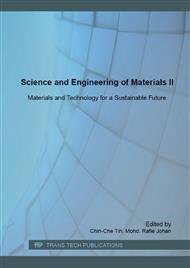[1]
J.G. Bonner, P.S. Hope, Compatibilisation and reactive blending, In polymer blends andAlloys, M.J. Folkes and P.S. Hope, (eds. ). Blackkie Academic and Professional, London, 1993, Chapter 3.
DOI: 10.1007/978-94-011-2162-0_3
Google Scholar
[2]
J.T. Andrew, P.J. Kevin, Blends of natural rubber novel techniques for blending with speciality polymers, London: Chapman and Hall, (1998).
Google Scholar
[3]
F.W. Barlow, Rubber compounding : principles, materials and techniques. 2nd Edition, Marcel Dekker, Inc., New York, (1993).
Google Scholar
[4]
P. Soo-Jin, C. Ki-sook, Fill-elastomer interactions : influence of silica coupling agent on crosslink density and thermal stability of silica of silica/rubber composites. Journal of colloid and interface Science, 267(2003) 86-91.
DOI: 10.1016/s0021-9797(03)00132-2
Google Scholar
[5]
K. Kongsin, V.L. Micheeal, Improving the morphology and properties of NR/NBR blends with polychloroprene as the compatibilizing agent. In J.T. Andrew and P.J. Kevin, Blends of natural rubber: novel techniques for blending with speciality polymer. London ; Chapman and Hall, 1998, pp.80-93.
DOI: 10.1007/978-94-011-4922-8_7
Google Scholar
[6]
A.R. Bhattacharyya, A.K. Ghosh A. Misra and K.J. Eichhorn, Reactively compatibilised polyamide 6/ ethylene-co-vinyl acetate blends: mechanical properties and morphology. Polymer, 46(2005) 1661-1674.
DOI: 10.1016/j.polymer.2004.12.012
Google Scholar
[7]
V.L. Micheal, NR/NBR blends-basic problems and solutions. In J.T. Andrew and P.J. Kevin, Blends of natural rubber: novel techniques for blending with speciality polymer. London ; Chapman and Hall, 1998, pp.53-67.
DOI: 10.1007/978-94-011-4922-8_5
Google Scholar
[8]
C. Sirisinha, S. Baulek-Limcharoen and J. Thunyarittikorn, Relationships among blending condition, size of dispersed phase, and oil resistance in natural rubber and nitrile rubber blends. Journal of Applied Polymer Science, 82(2001) 1232-1237.
DOI: 10.1002/app.1957
Google Scholar
[9]
Z.P. Fang, G.W. Ma, B.Q. Shentu, G.P. Cai and C.W. Xu, Influence of viscosity ratio on the morphology of PVC/PE blends. European Polymer Journal, 36(10)(2000) 2309-2311.
DOI: 10.1016/s0014-3057(99)00275-x
Google Scholar
[10]
R. Tol, G. Groeninckx, I. Vinckier, P. Moldenaers and J. Mewis, Pase morphology and stability of co–continuous (PPE/PS)/ PA6 and PS/ PA6 blends: Effect of rheology and reactive compatibilization. Polymer, 45(8)(2004) 2587 – 2601.
DOI: 10.1016/j.polymer.2003.12.072
Google Scholar
[11]
S.C. Jana, M. Sau, Effects of viscosity ratio and composition on development of morphology in chaotic mixing of polymers. Polymer, 45(2004) 1665–1678.
DOI: 10.1016/j.polymer.2003.12.047
Google Scholar
[12]
I.R. Gelling, Epoxidised natural rubber. J. Nat Rub., 6(1991) 184-205.
Google Scholar
[13]
N. Rattanasom, T. Saowapark and C. Deeprasertkul, Reinforcement of natural rubber with silica/carbon black hybrid filler. Polymer Testing, 26(2007) 369-377.
DOI: 10.1016/j.polymertesting.2006.12.003
Google Scholar
[14]
S.Y. Lee, J.H. Kim and B.K. Kim, Natural rubber blends with epoxidized natural rubber. J. Macrom. Sci., 36(1997) 579-594.
DOI: 10.1080/00222349708220443
Google Scholar
[15]
Y. Heping, L. Sidong and P. Zheng, Preparation and study of epoxidized natural rubber. Journal of Thermal Analysis and Calorimetry, 58(1999) 293-299.
DOI: 10.1023/a:1010199013587
Google Scholar
[16]
C.K.L. Davies, S.V. Woffe, I.R. Gelling and A.G. Thomas, Strain crystallization in random copolymers produced by epoxidation of cis-1, 4-Polyisoprene. Polymer, 24 (1983) 107-113.
DOI: 10.1016/0032-3861(83)90090-3
Google Scholar
[17]
H. Ismail, M.N. Nasaruddin and U.S. Ishiaku, White rice husk ash filled natural rubber compounds : the effect of multifunctional additive and silane coupling agents. Polymer Testing, 18 (1999) 287-298.
DOI: 10.1016/s0142-9418(98)00030-0
Google Scholar


